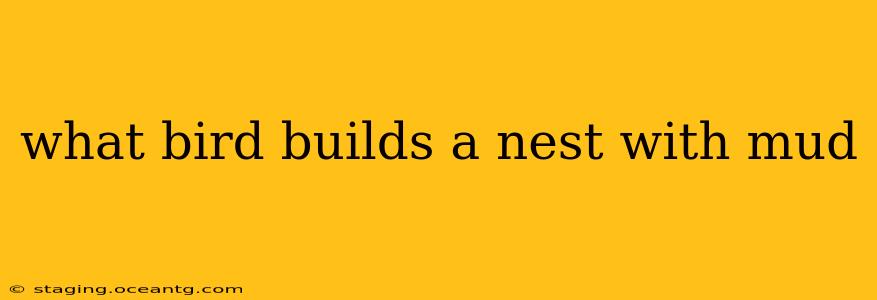Many birds incorporate mud into their nest construction, using it for various purposes like strengthening the structure, providing waterproofing, or creating a secure, camouflaged home. While some birds use mud sparingly, others rely on it heavily, crafting truly impressive mud nests. Let's explore some of these fascinating avian architects.
What types of birds use mud in their nests?
Several bird families are known for their mud-based nest construction techniques. These include:
-
Swallows (Hirundinidae): Various swallow species, such as barn swallows and cliff swallows, are renowned for their mud nests. They skillfully mix mud with saliva to create sturdy cups or elaborate structures attached to cliffs, bridges, or eaves. The mud provides structural integrity and helps protect their eggs and young from the elements.
-
Ovenbirds (Furnariidae): These South American birds are masters of mud architecture, constructing dome-shaped nests that resemble ovens (hence the name). These nests are incredibly strong and well-insulated, offering significant protection to their offspring.
-
Hornbills (Bucerotidae): Some hornbill species use mud in their nest construction, often incorporating it into cavities in trees to create a secure and enclosed nesting space.
-
Ibises and Spoonbills (Threskiornithidae): Certain species within this family may utilize mud to line their nests or build platforms in trees or reeds.
-
Wagtails (Motacillidae): Some wagtail species will incorporate mud into their nest construction, using it as a binding agent to secure other materials.
How do birds build nests with mud?
The process of mud nest construction varies depending on the bird species, but generally involves these steps:
-
Gathering Materials: Birds carefully select mud with the right consistency – not too wet, not too dry – often from riverbanks, puddles, or moist soil.
-
Mixing and Shaping: Many birds mix the mud with saliva or other binding agents like plant fibers or grasses to improve its adhesive properties and create a workable consistency. They then carefully shape and layer the mud, using their beaks and feet to build the nest structure.
-
Drying and Strengthening: The mud needs time to dry and harden, creating a robust and protective nest. Some birds may add additional materials like twigs, grasses, or feathers for insulation and comfort after the mud has dried.
What are the benefits of using mud in bird nests?
The use of mud in nest construction offers several advantages:
-
Strength and Stability: Mud provides structural support, helping to create a stable and durable nest that can withstand strong winds and rain.
-
Protection from Predators: The thick walls of some mud nests offer excellent protection from predators trying to reach the eggs or young.
-
Camouflage: The mud's color often blends well with the surrounding environment, providing camouflage and helping to conceal the nest from predators.
-
Insulation: Mud nests can help regulate temperature, protecting the eggs and chicks from extreme heat or cold.
What are some examples of mud nests?
The diversity of mud nests is truly remarkable. The elaborate, flask-shaped nests of cliff swallows, clinging to cliffsides in massive colonies, are a stunning example. The ovenbird's dome-shaped, meticulously crafted mud nests are another testament to avian ingenuity. Each species demonstrates unique adaptations in their mud nest building techniques, reflecting the diverse habitats and ecological pressures they face.
Are all mud nests the same?
Absolutely not! The size, shape, and overall design of mud nests vary widely depending on the bird species, their habitat, and available resources. Some nests are simple, cup-shaped structures, while others are complex, multi-chambered creations. This diversity underscores the remarkable adaptability and architectural skills of these avian builders.
This exploration sheds light on the fascinating world of birds that build nests with mud. Their ingenuity and precision in construction are a testament to the power of natural selection and adaptation. The next time you see a mud nest, take a moment to appreciate the remarkable skills and effort that went into its creation.
